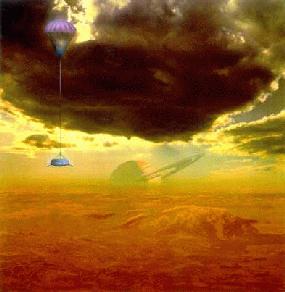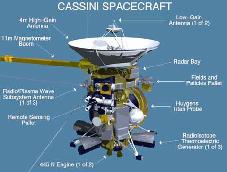Cassini/Huygens Mission
The Cassini/Huygens Mission consists of the main spacecraft Cassini, developed and built by the NASA, and the Huygens Probe, developed by the ESA. The scientific object of the Cassini/Huygens Mission is Saturn and its moons, especially Titan.
Cassini has been successfully launced on 15 October 1997. The spacecraft is in the Saturnian system since July 2004.
Cassini Orbiter Experiments
- Imaging Science Subsystem: Takes pictures in visible, near-ultraviolet and near-infrared light.
- Cassini Radar: Maps surface of Titan using radar imager to pierce veil of haze. Also used to measure heights of surface features.
- Radio Science Subsystem: Searches for gravitational waves in the universe; studies the atmosphere, rings and gravity fields of Saturn and its moons by measuring telltale changes in radio waves sent from the spacecraft.
- Ion and Neutral Mass Spectrometer: Examines neutral and charged particles near Titan, Saturn and the icy satellites to learn more about their extended atmospheres and ionospheres.
- Visual and Infrared Mapping Spectrometer: Identifies the chemical composition of the the surfaces, atmospheres and rings of Saturn and its moons by measuring colours of visible light and infrared energy given off by them.
- Composite Infrared Spectrometer: Measures infrared energy from the surfaces, atmospheres and rings of Saturn and its moons to study their temperature and composition.
- Cosmic Dust Analyzer: Studies ice and dust grains in and near the Saturn system.
- Radio and Plasma Wave Science: Investigates plasma waves (generated by ionized gases flowing out from the Sun or orbiting Saturn), natural emissions of radio energy and dust.
- Cassini Plasma Spectrometer: Explores plasma (highly ionized gas) within and near Saturn's magnetic field.
- Ultraviolet Imaging Spectrograph: Measures ultraviolet energy from atmospheres and rings to study their structure, chemistry and compositon.
- Magnetospheric Imaging Instrument: Images Saturn's magnetosphere and measures interactions between the magnetosphere and the solar wind, a flow of ionized gases streaming out from the Sun.
- Dual Technique Magnetometer: Describes Saturn's magnetic field and its interactions with the solar wind, the rings, and the moons of Saturn.
Huygens Probe Experiments
- Descent Imager and Spectral Radiometer: Makes images and measures temperatures of particles in Titan's atmosphere and on Titan's surface.
- Huygens Atmospheric Structure Instrument: Explores the structure and physical properties of Titan's atmosphere.
- Gas Chromatograph and Mass Spectrometer: Measures the chemical composition of gases and suspended particles in Titan's atmosphere.
- Aerosol Collector Pyrolyzer: Examines clouds and suspended particles in Titan's atmosphere.
- Surface Science Package: Investigates the physical properties of Titan's surface.
- Doppler Wind Experiment: Studies Titan's winds from their effect on the probe during its descent.
Since the Voyager 1 fly-by at Titan we know that Titan has an atmosphere comparable with the proto-atmosphere of the Earth. It is rich in nitrogen and complex organic molecules that cause orange dust and inhibits the view of Titan's surface. These organic molecules should ultimately fall down, perhaps simililarly to the Earth as life had formed. Therefore, it is extraordinarily interesting to understand the chemistry of Titan's atmosphere.

The only scientific goal of the Huygens Probe is the investigation of Titan's atmosphere and surface. About five months after the arrival of Cassini at Saturn, Cassini will separate the Huygens Probe which will then descend into Titan's atmosphere. The heat shield will protect Huygens from the high temperatures during the penetration of the atmosphere. In 180 km altitude the main parachute will be opened that will slow down the fall and immediately the instruments on Huygens will begin to operate. During the descent temperature, density, pressure, and composition of the atmosphere and the wind velocity will be measured. After breaking through possible clouds the camera will take photographs of the environment and the surface. If the probe survives the bound against Titan, also measurements of the surface will be done, and the results will be transmitted via Cassini. Cassini itself will encounter Titan at least 44 times and scan Titan's surface by radar, so the first map of Titan's surface can be completed. We hope to get such impressive images like the radar images of Venus.
You can find details about each instrument or experiment of Cassini/Huygens on the homepages listed on the next page.
Authors: Dorothea Mücke-Herzberg, Tetsuya Tokano

